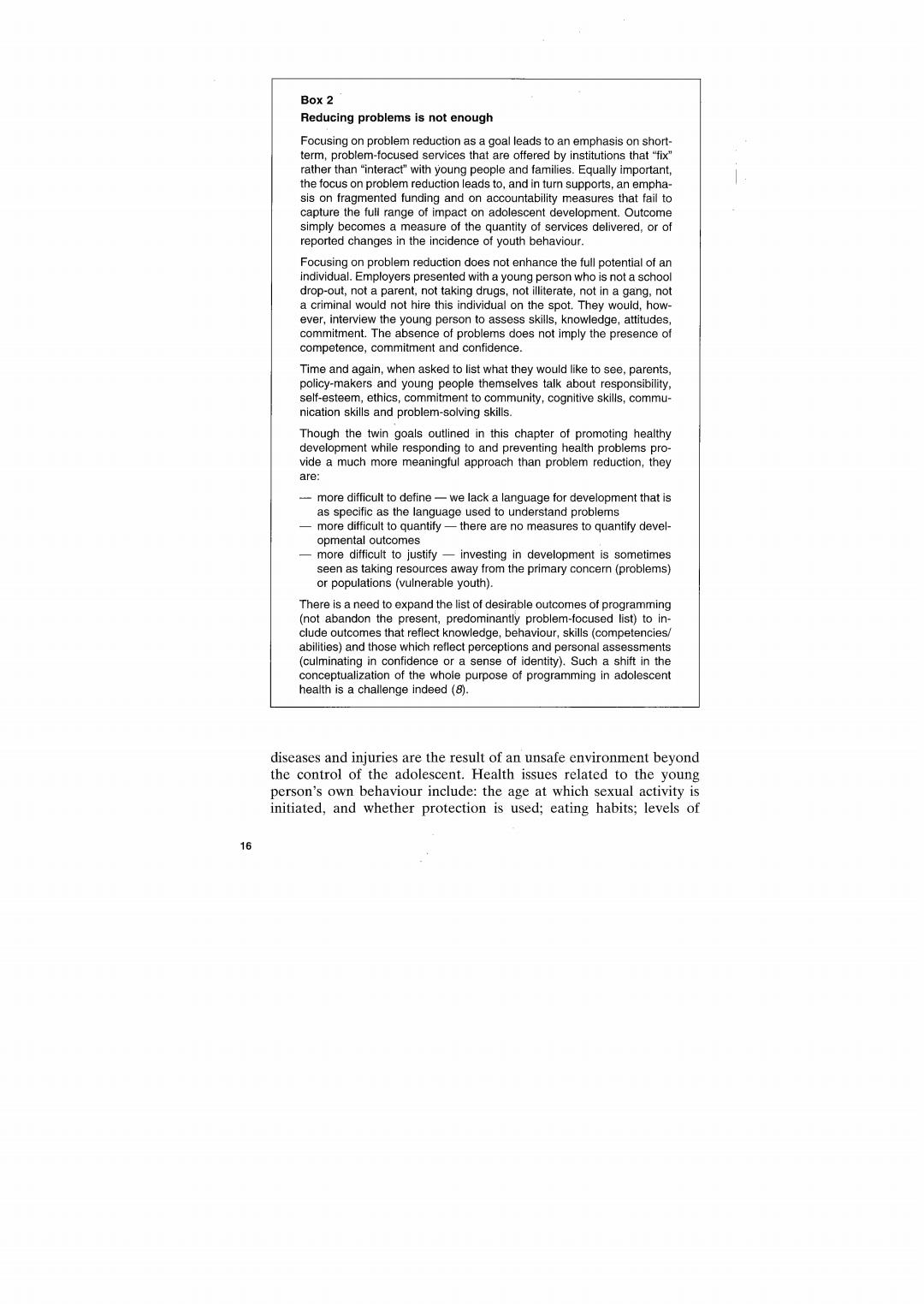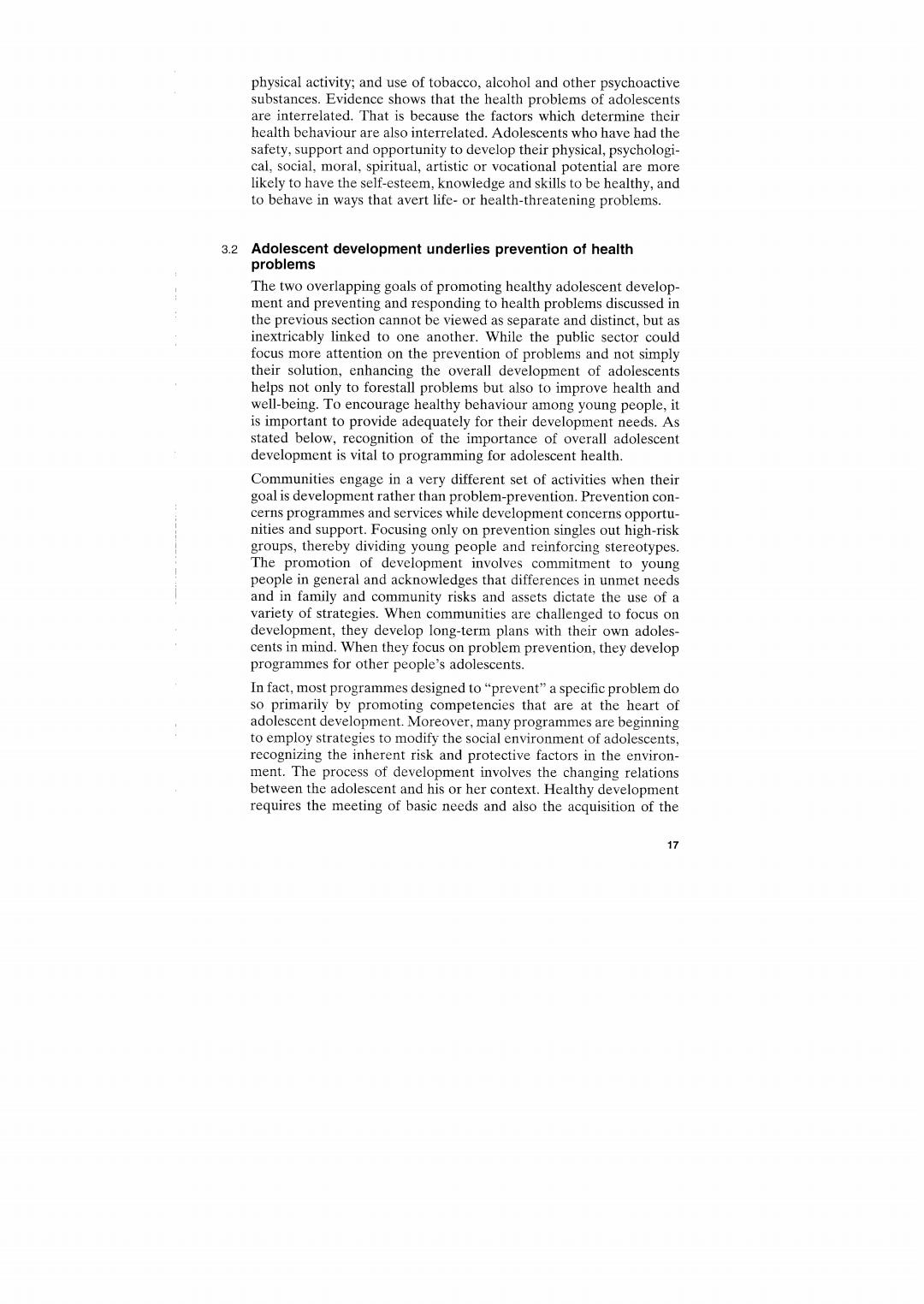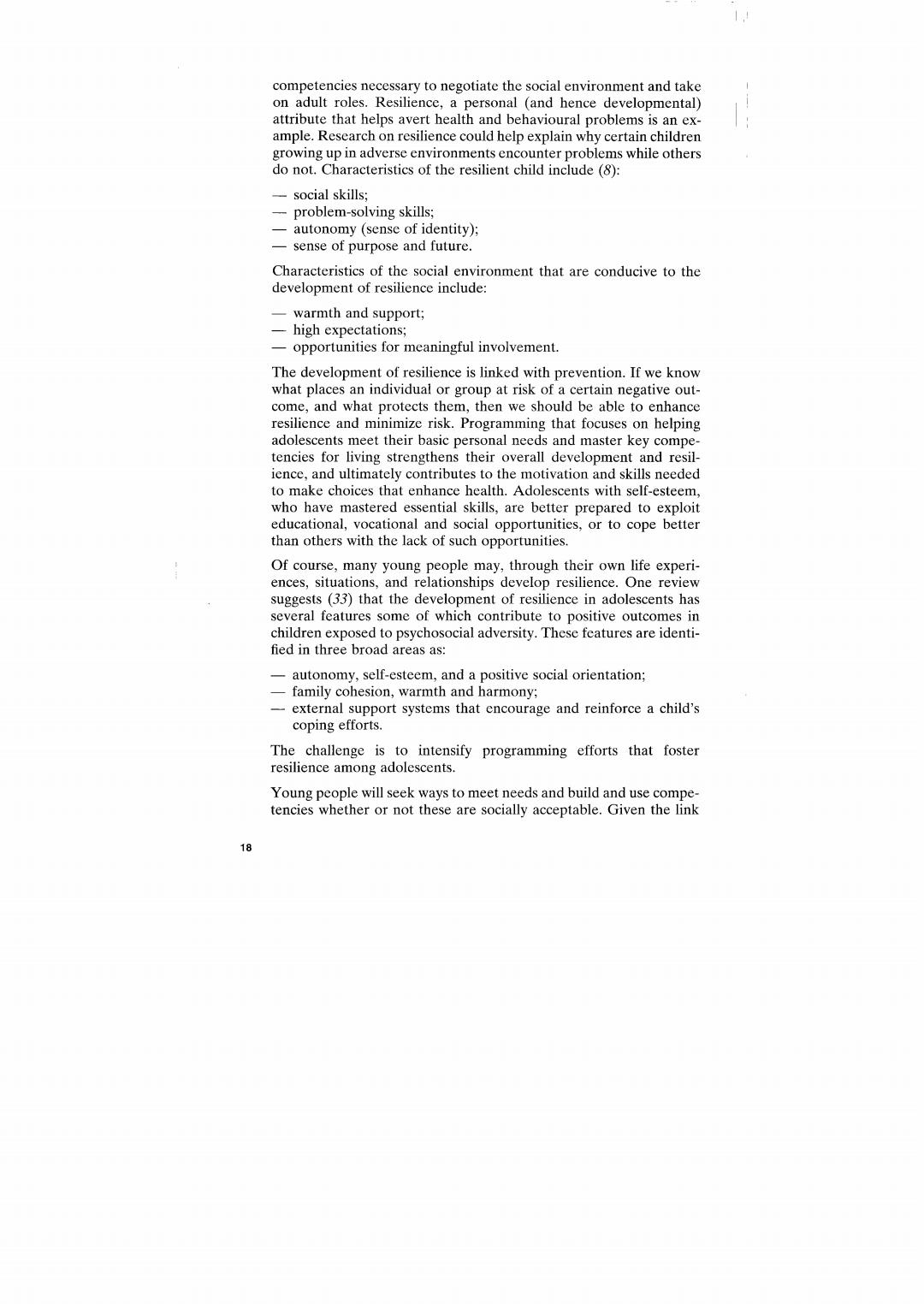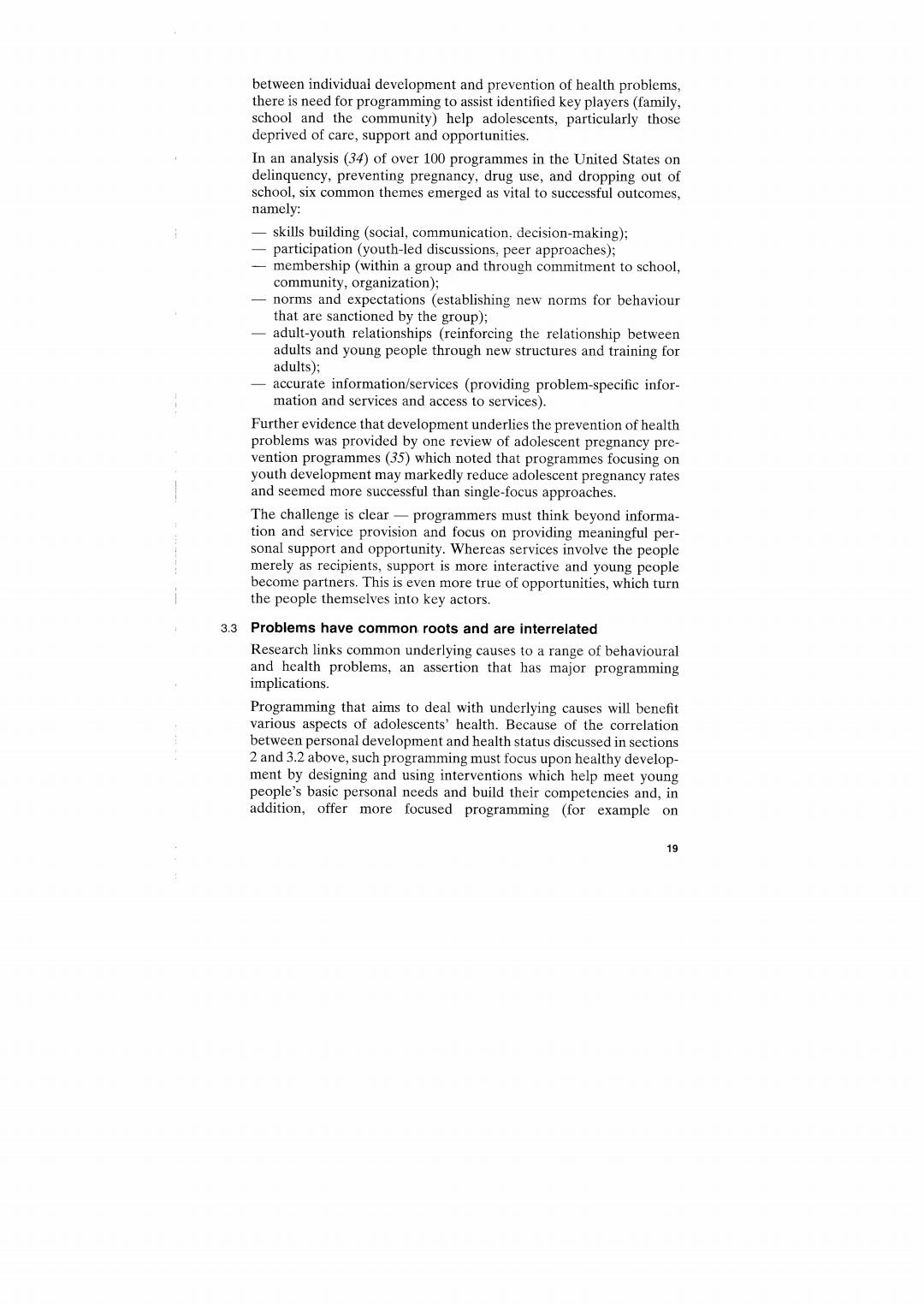
Box 2 Reducing problems is not enough Focusing on problem reduction as a goal leads to an emphasis on short- term,problem-focused services that are offered by institutions that"fix'" rather than"interact"with young people and families.Equally important, the focus on problem reduction leads to,and in turn supports,an empha- sis on fragmented funding and on accountability measures that fail to capture the full range of impact on adolescent development.Outcome simply becomes a measure of the quantity of services delivered,or of reported changes in the incidence of youth behaviour. Focusing on problem reduction does not enhance the full potential of an individual.Employers presented with a young person who is not a school drop-out,not a parent,not taking drugs,not illiterate,not in a gang,not a criminal would not hire this individual on the spot.They would,how- ever,interview the young person to assess skills,knowledge,attitudes, commitment.The absence of problems does not imply the presence of competence,commitment and confidence. Time and again,when asked to list what they would like to see,parents, policy-makers and young people themselves talk about responsibility, self-esteem,ethics,commitment to community,cognitive skills,commu- nication skills and problem-solving skills. Though the twin goals outlined in this chapter of promoting healthy development while responding to and preventing health problems pro- vide a much more meaningful approach than problem reduction,they are: more difficult to define-we lack a language for development that is as specific as the language used to understand problems more difficult to quantify-there are no measures to quantify devel- opmental outcomes more difficult to justify-investing in development is sometimes seen as taking resources away from the primary concem(problems) or populations (vulnerable youth). There is a need to expand the list of desirable outcomes of programming (not abandon the present,predominantly problem-focused list)to in- clude outcomes that reflect knowledge,behaviour,skills(competencies/ abilities)and those which reflect perceptions and personal assessments (culminating in confidence or a sense of identity).Such a shift in the conceptualization of the whole purpose of programming in adolescent health is a challenge indeed (8). diseases and injuries are the result of an unsafe environment beyond the control of the adolescent.Health issues related to the young person's own behaviour include:the age at which sexual activity is initiated,and whether protection is used;eating habits;levels of 16

physical activity;and use of tobacco,alcohol and other psychoactive substances.Evidence shows that the health problems of adolescents are interrelated.That is because the factors which determine their health behaviour are also interrelated.Adolescents who have had the safety,support and opportunity to develop their physical,psychologi- cal,social,moral,spiritual,artistic or vocational potential are more likely to have the self-esteem,knowledge and skills to be healthy,and to behave in ways that avert life-or health-threatening problems. 3.2 Adolescent development underlies prevention of health problems The two overlapping goals of promoting healthy adolescent develop- ment and preventing and responding to health problems discussed in the previous section cannot be viewed as separate and distinct.but as inextricably linked to one another.While the public sector could focus more attention on the prevention of problems and not simply their solution,enhancing the overall development of adolescents helps not only to forestall problems but also to improve health and well-being.To encourage healthy behaviour among young people,it is important to provide adequately for their development needs.As stated below,recognition of the importance of overall adolescent development is vital to programming for adolescent health. Communities engage in a very different set of activities when their goal is development rather than problem-prevention.Prevention con cerns programmes and services while development concerns opportu nities and support.Focusing only on prevention singles out high-risk groups,thereby dividing young people and reinforcing stereotypes. The promotion of development involves commitment to young people in general and acknowledges that differences in unmet needs and in family and community risks and assets dictate the use of a variety of strategies.When communities are challenged to focus on development,they develop long-term plans with their own adoles- cents in mind.When they focus on problem prevention,they develop programmes for other people's adolescents. In fact,most programmes designed to"prevent"a specific problem do so primarily by promoting competencies that are at the heart of adolescent development.Moreover,many programmes are beginning to employ strategies to modify the social environment of adolescents, recognizing the inherent risk and protective factors in the environ- ment.The process of development involves the changing relations between the adolescent and his or her context.Healthy development requires the meeting of basic needs and also the acquisition of the

competencies necessary to negotiate the social environment and take on adult roles.Resilience,a personal (and hence developmental) attribute that helps avert health and behavioural problems is an ex- ample.Research on resilience could help explain why certain children growing up in adverse environments encounter problems while others do not.Characteristics of the resilient child include (8): -social skills: -problem-solving skills: -autonomy (sense of identity); -sense of purpose and future Characteristics of the social environment that are conducive to the development of resilience include: warmth and support; -high expectations; opportunities for meaningful involvement. The development of resilience is linked with prevention.If we know what places an individual or group at risk of a certain negative out- come,and what protects them,then we should be able to enhance resilience and minimize risk.Programming that focuses on helping adolescents meet their basic personal needs and master key compe- tencies for living strengthens their overall development and resil- ience,and ultimately contributes to the motivation and skills needed to make choices that enhance health.Adolescents with self-esteem. who have mastered essential skills,are better prepared to exploit educational,vocational and social opportunities,or to cope better than others with the lack of such opportunities Of course,many young people may,through their own life experi- ences,situations,and relationships develop resilience.One review suggests (33)that the development of resilience in adolescents has several features some of which contribute to positive outcomes in children exposed to psychosocial adversity.These features are identi- fied in three broad areas as: autonomy,self-esteem,and a positive social orientation; -family cohesion,warmth and harmony; external support systems that encourage and reinforce a child's coping efforts. The challenge is to intensify programming efforts that foster resilience among adolescents. Young people will seek ways to meet needs and build and use compe- tencies whether or not these are socially acceptable.Given the link

between individual development and prevention of health problems, there is need for programming to assist identified key players(family, school and the community)help adolescents,particularly those deprived of care,support and opportunities. In an analysis (34)of over 100 programmes in the United States on delinquency,preventing pregnancy,drug use,and dropping out of school,six common themes emerged as vital to successful outcomes, namely: skills building (social,communication,decision-making); -participation(youth-led discussions,peer approaches); membership (within a group and through commitment to school. community,organization); norms and expectations(establishing new norms for behaviour that are sanctioned by the group); adult-youth relationships (reinforcing the relationship between adults and young people through new structures and training for adults); accurate information/services (providing problem-specific infor- mation and services and access to services). Further evidence that development underlies the prevention of health problems was provided by one review of adolescent pregnancy pre- vention programmes(35)which noted that programmes focusing on youth development may markedly reduce adolescent pregnancy rates and seemed more successful than single-focus approaches. The challenge is clear-programmers must think beyond informa- tion and service provision and focus on providing meaningful per- sonal support and opportunity.Whereas services involve the people merely as recipients,support is more interactive and young people become partners.This is even more true of opportunities,which turn the people themselves into key actors. 3.3 Problems have common roots and are interrelated Research links common underlying causes to a range of behavioural and health problems,an assertion that has major programming implications. Programming that aims to deal with underlying causes will benefit various aspects of adolescents'health.Because of the correlation between personal development and health status discussed in sections 2 and 3.2 above,such programming must focus upon healthy develop- ment by designing and using interventions which help meet young people's basic personal needs and build their competencies and,in addition,offer more focused programming (for example on 多

information,counselling or health-service provision),to further ad- dress specific behaviour and health problems as needed. A clear example of this would be programming which addresses self- esteem and the mastery of assertiveness skills,in conjuction with an HIV/AIDS information campaign,and concurrently offers the oppor- tunity to practise assertiveness skills through role-playing.The same basic self-esteem and assertiveness skills will also help to address the desire to use drugs,or improve the ability to resist pressure to use them.In parallel,health education programmes on substance use may adopt other interventions to address a particular risk in a given location.In such ways,programming to enhance programmes and more specific interventions can complement and strengthen each other. Problem behaviour theory identifies several common determinants of diverse behaviour which underlies the health problems that typically concern the public.Hence,interventions should be directed at the common determinants of the set of problem behaviours rather than at the separate manifest behaviour.Interventions that focus only on the specific behaviour,like drug use or sexual activity,are less effective because they do not address the antecedents or determinants of the behaviour (34). Recognition that specific attention to one problem will also help to reduce problems in another area is a concept that can be used to guide programming.Examples here include some familiar correlations- unprotected sex increases the risk of both unwanted pregnancy and infection with STDs (including HIV/AIDS);intravenous drug use can also spread HIV;alcohol and other drug abuse can lead to increased accidents and violence,including homicides. The concept that certain problems have common causes has been validated by findings in a recent study in Cape Town,South Africa, showing that risky types of behaviour involving sexuality,smoking, alcohol and drug use,and suicide are strongly related (36).In the juvenile justice sector,work with persistent offenders has identified a "constellation"of personal and social factors which appear to con- tribute to their criminal behaviour.The factors include breakdown in family relations,high levels of abuse and neglect,learning difficulties and school failure,poor skills development,deterioration in self- esteem,abuse of alcohol and other drugs(37). 3.4 Adolescence is a time of opportunity and risk Adolescence is not simply extended childhood.When the child be comes an adolescent,major physical and psychosocial changes occur. 20